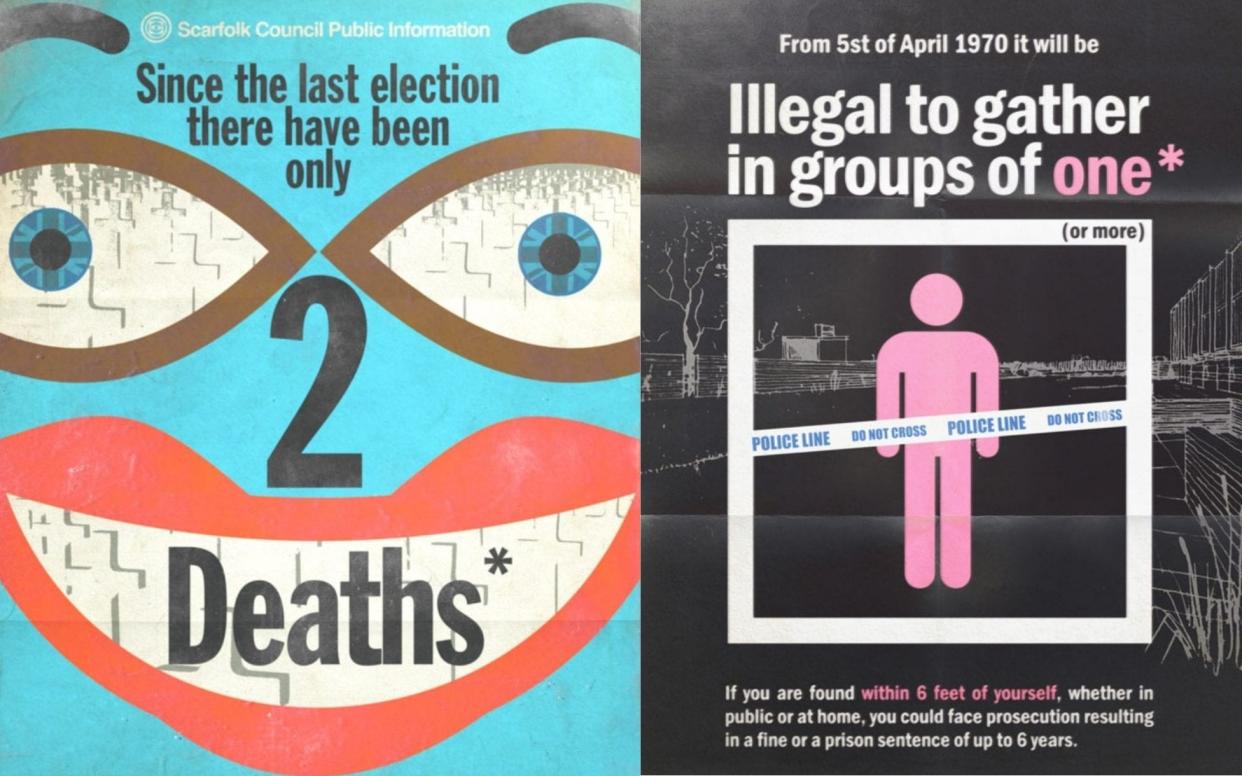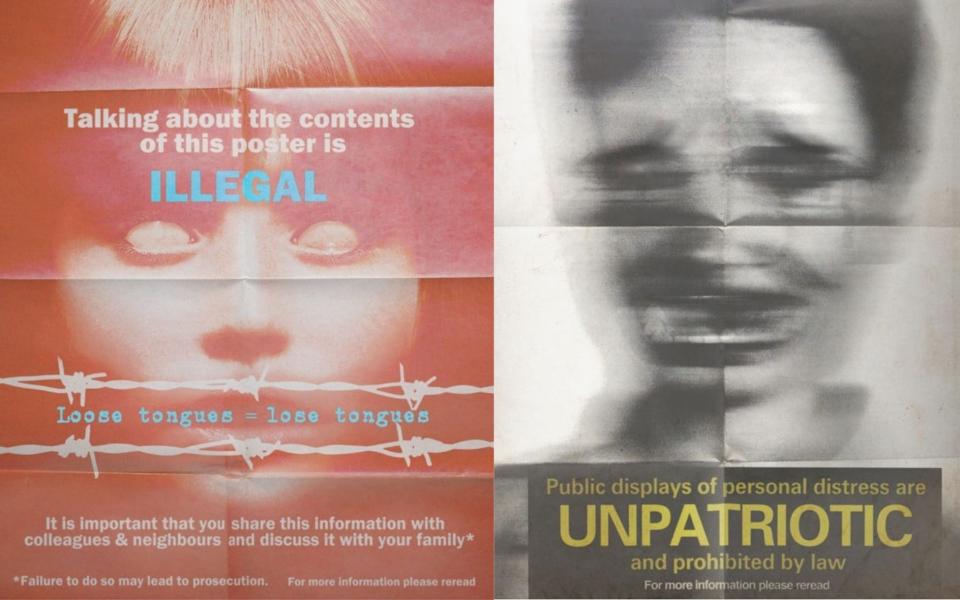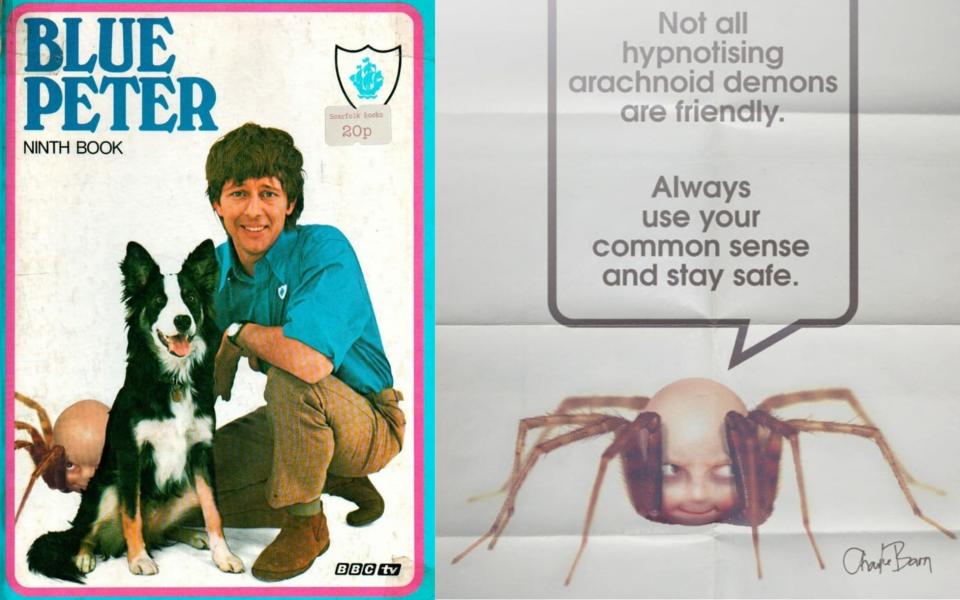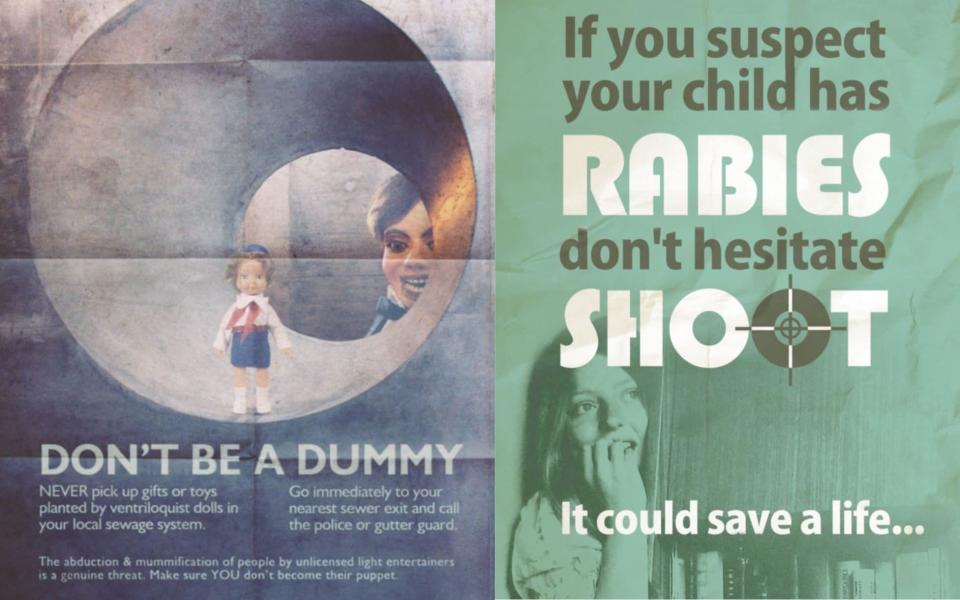‘Keep calm and carry on – or die’: did this cult art project inspire the Government’s Covid posters?

Whenever I’m in London, on Victoria station, I know I’m being watched by a man. He looks unassuming, with his round-neck jumper and tidy hair. He never removes his face-mask, which covers his nose and mouth. He’s watching you as well; he’s watching everyone, night and day.
While talking to the graphic artist Richard Littler – over Zoom, since he lives in Bern – I tell him about this man, who appears on the Government’s anti-Covid poster campaign. You see him across the country, on the streets and pasted on walls; a figure with an empty face, warning of fines for people who disobey the rules.
Ensconced in Switzerland, Littler hadn’t seen these signs before. He’s doubtful about their tone, a blend of serenity and doom. “Because the information is friendly and straightforward,” he says, “when [the posters] juxtapose it with what may or may not happen, you might feel patronised. ‘Face’, ‘space’, ‘hands’. I mean, it’s just three random nouns! You could substitute them for anything else. And doing it in threes is like talking to infants, like a kindergarten teacher saying: “Have you washed your hands? Or you might die of cancer!” That’s a bit Scarfolk-y.”
Which is why I wanted to talk to him. “Scarfolk” is the cult art project on which Littler has worked, alone, since 2013. It began as a blog, with mocked-up government posters and other graphic art, about a town in north-west England that became trapped in the Seventies – the decade runs on a hellish loop. The three-day week, it seems, was as good as it ever got. “Stray foreigners, prisoners and children nobody wanted” have their faces surgically removed; children win stars for identifying corpses; the hearts of the deceased are transplanted into dolls. It’s funny, in the blackest way. People are abducted by “unlicensed light entertainers” who live inside the sewers; children buy tapes of “Sing-A-Long IRA Telephone Bomb Threats”, thanks to the BBC.
Since Scarfolk began, it has burgeoned into two books, a optioned TV project and “a couple of other merchandise-type things”, of which the latest, arriving for Christmas, is Scarfolk & Environs, a fold-out map of the unlucky town. The project began, Littler explains, as “quite a personal thing… an arsy and arty idea, dealing with demons I had as a child. I suffered from night terrors – lots of nightmares.” But he tired of himself, and broadened the setting to “the culture at large, the repetitions, the fears of society rather than just this individual.” His online audience grew; Ian Rankin, Al Murray and Mark Gatiss are fans of Littler’s faded imagery.

“It was important to me,” Littler says, “that things in Scarfolk looped – that they didn’t change at all. It seemed to me that things [in the real world] were certainly looping. Take the rise of fascism in the early 20th century. I’m not saying that it might become like that again, but it’s like: 'We’ve had that before, we’ve had that before, we’ve had that before...' So I created an environment in which that happens – a science-fiction, supernatural world.”
With their sinister visuals and sans-serif fonts, his designs are exquisitely dark. You’re enjoying a nightmare from the safety of day, keeping the Seventies at a safe remove. And many of the project’s vignettes, however gothic, couldn’t belong to another time. Scarfolk might seem like other fictional towns – Royston Vasey, The Village – but this was a decade in which British Transport Films made The Finishing Line, in which children are graphically crushed by an express. One troubling figure is “Charlie Barn”, a “paranormal, spider-like entity discovered in the vast, labyrinthine bunker beneath the Scarfolk council office building”. His story goes like this:
Barn employed mind-control techniques to trick people into making him famous, and was a regular guest on British TV throughout the Seventies. He appeared in children’s programmes such as Blue Peter, and as a cartoon character in Paddington. He also hosted his own show, Barn’s Owls, which saw him hunt, disembowel and eat large owls (later revealed to be orphans dressed as owls) in front of a live studio audience.
Worse things happened on kids’ TV.

“I always avoid the word ‘nostalgia’,” Littler says, “because I don’t think anybody would want to return to Scarfolk. I’m trying to colour or manipulate people’s own memories. Because there’s a lot of area around them, I can fill in the gaps with awful fictions. But you can only do that if you can give people something that was ephemeral, that didn’t survive the period culturally. If you give them ABBA, lava lamps and discos, it doesn’t work. You’ve got to use an ITV Schools and Colleges image, so that people say, ‘I haven’t seen that in 50 years. What was I doing then?' Then Scarfolk says, 'Let me tell you.’”
Readers who are old enough can imagine themselves into Scarfolk’s streets. Isn’t it tempting to believe that, somewhere in the north-west, a paranormal entity really ate children on TV? And the public-information posters, which form the majority of the project, rely on familiarity – on our collective recognition of British graphic design.
“You can go back,” Littler explains, “to the posters in the Second World War – ‘the walls have eyes’ – the fear that Hitler was in your teacup, in the light fittings.” He doesn’t see the Government’s present campaign as a model of aplomb. “In the past, the public-information posters said: ‘Keep Calm and Carry On’. Now the modern ones say: ‘Keep Calm and Carry On – or Die!’
“I think people are perfectly happy to be informed,” he adds. “They want to know what the truth is, to know what they can and can’t do. In Switzerland, it’s straightforward: ‘These are the problems, this is what we’ll do, this is what we won’t.’” In Bern, he says, the authorities “trust you to get on with it”, which isn’t his impression of the British approach. “You’re getting a lot of exceptionalism and bluster from Boris Johnson. I think that that undermines [the public-information campaign] because it becomes less believable. Anyone with a keen eye for that sort of discourse can see right through it.”

But polls suggest that people don’t, or that they’re on board with the Government’s rules. Littler dislikes the word “Orwellian” too, but has to admit that the Government encouraging people to snitch on each other is “incredibly Orwellian”. And Scarfolk often plays on the fact that Britons are more compliant than they like to think. In the alternative 1978, the Government ran a campaign against “naughtiness”. “Many citizens criticised the state for treating them like children,” Littler writes. “The council denied this, but in January 1979, thousands received orders to put ‘fingers on lips’ while in public.”
And the citizens shut up. “Specially-trained police officers patrolled streets, public and private buildings, and handed out on-the-spot fines for various misdemeanours such as not standing up straight, running in corridors and not paying attention.” (As Littler said of “hands, face, space”, this is the link between the “kindergarten” and the power of the state.) This story concludes with 94 deaths – people who “raised their hands to go to the toilet, but were not given permission” – and the whole town being forced to “resit the Seventies”.
The looping has a limit; Scarfolk will come to an end. “There has to be a lifespan,” Littler admits. “You don’t want to be repeating yourself too much when you think people have got the idea.” Besides, he adds, “it would be nice to do something completely different for a while. Some other kind of thing that isn’t miserable.” In the meantime, there’s the forthcoming map-pack – complete with “adverts for hotels and theme-parks, ‘kids go free’-type things, an ID card, a visa” – and he hopes that the TV project will finally bear some fruit.

And Littler’s plan to “colour and manipulate” our memories may have entered what passes for the Government’s brain. “Last year,” he says, “they published a document about the history of public-information campaigns. And they accidentally used a Scarfolk post about shooting rabid children. It was reported everywhere, even in Russia – a viral thing – and it elicited a response from the Government’s press officer, who said that it had been done in error.”
This year, however, the error seems to have become a tic. “Michael Gove started following me [on Twitter], in about March or April. So did James Cleverly, and a couple of others. And within a month, the public-information campaign started having Scarfolkian elements – aged paper textures, and a slightly retro feel. People were saying to me, ‘This is insane, they’re imitating a dystopia! Are you working for the Government?’”
He shakes his head. “I don’t know what to do with that. I really don’t know what to say.” Littler’s work is over. We all live in Scarfolk now.
Scarfolk & Environs: Road & Leisure Map For Uninvited Tourists will be published on November 2. See herblester.com for details

